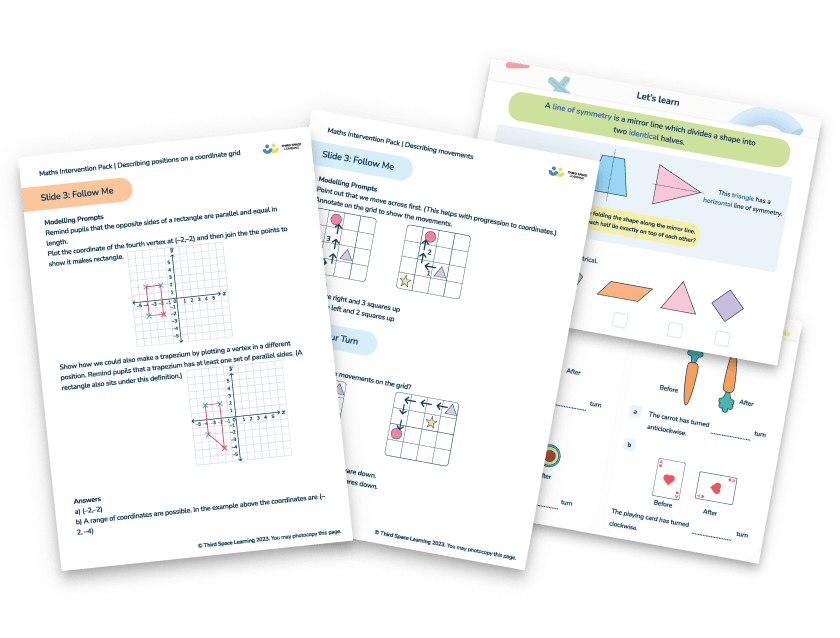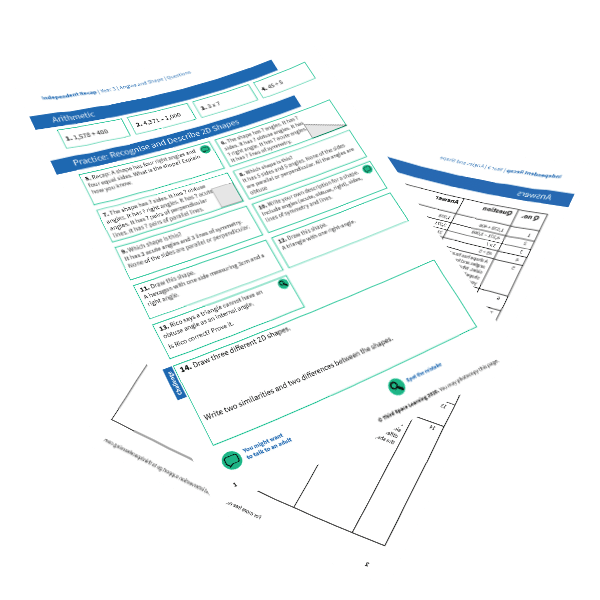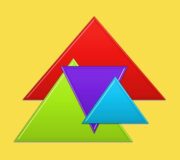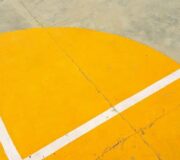What Are 2D Shapes And Which 2D Shapes Should Kids Learn At Primary School?
Children start learning about 2D shapes from as early as year 1 in primary school, so here is everything you need to know to support them. We cover the the two-dimensional shapes children will need to have mastered in each year group from the familiar such as squares and triangles to the less familiar polygons. We also look at the properties of 2D shape that children are expected to know.
Let’s kick off with some definitions!
What are 2D shapes?
2D shapes are shapes with two dimensions, such as width and height. An example of a 2D shape is a rectangle or a circle. 2D shapes are flat and cannot be physically held, because they have no depth; a 2D shape is completely flat.
What does 2D mean?
2D in 2D shapes stands for 2-dimensional. We normally talk about dimensions as measurements in a direction. Examples of dimensions include length, width or breadth, depth and height.
The thin plastic shapes that are sometimes used to represent common 2D shapes are actually 3D because they do have depth to them – even if it’s very small.
2D Shapes Worksheet Year 3
Download this FREE recognising 2D shapes Geometry worksheet for Year 3 pupils, from our Independent Recap collection.
Download Free Now!Which 2D shapes do children learn about?
In primary school, children will learn about the following 2d shapes: polygons, regular and irregular shapes.
- A polygon is a 2D shape with straight sides.
- A regular shape has all sides the same length and all interior angles the same size.
- An irregular shape has different length sides and/or interior angles.
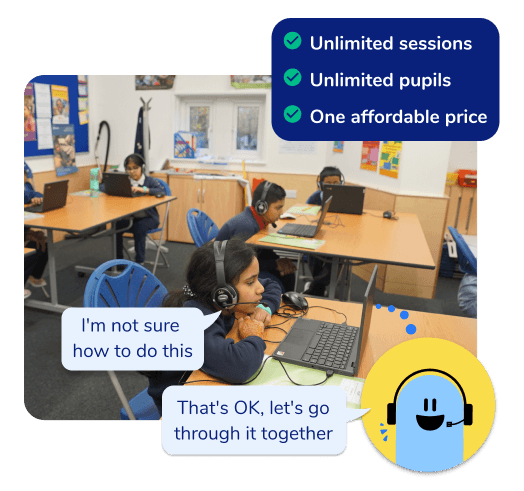
Unlimited primary maths tutoring with Skye, the voice-based AI maths tutor.
Built on the same principles, pedagogy and curriculum as our traditional tutoring but with more flexibility, reach and lower cost.
Join the schools already helping hundreds of primary pupils nationwide with Skye’s one to one maths tutoring
Watch Skye in actionWhat are the properties of 2D shapes?
The properties of 2D shapes refer to their sides and angles. When we move on to 3D shapes we talk about faces, edges and vertices.
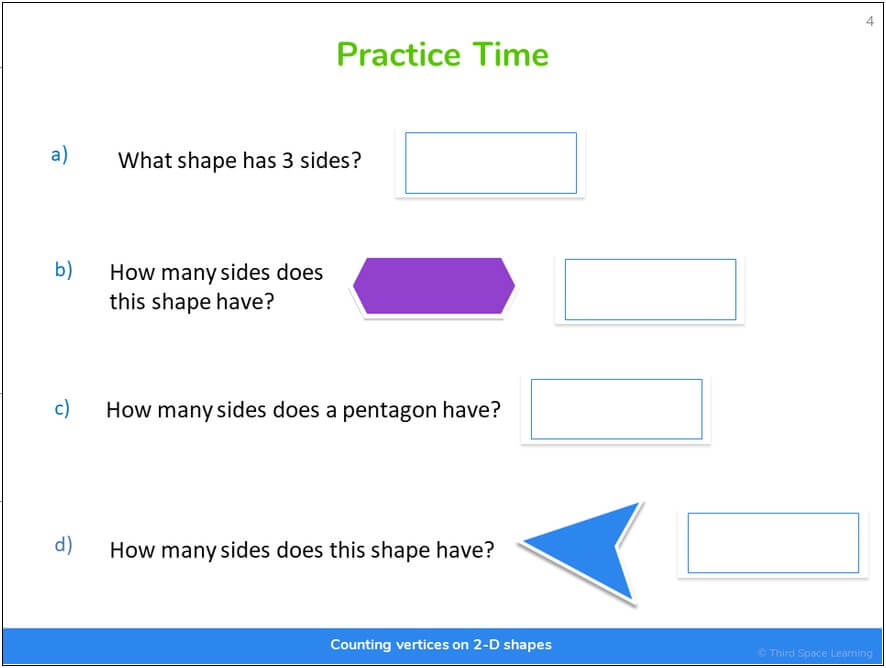
Properties of 2D shapes
As well as the names, children need to know the properties of 2D shapes as listed below and in the printable table.
Circles
- A circle has 1 curved side
- A semi-circle has 2 sides; 1 curved side and 1 straight side. The full arc is a 180° angle.
Triangles (3-sided shapes)
- An equilateral triangle is a regular triangle and each angle equals 60°.
- A right-angled triangle is any triangle with one right angle.
- A scalene triangle is an irregular triangle. All sides and angles are different.
- An isosceles triangle has two sides and two angles that are the same.
Quadrilaterals (4-sided shapes)
- A square is a regular quadrilateral and each angle equals 90°.
- A kite has two pairs of equal-length sides and the diagonals cross at right-angles.
- A rectangle has two pairs of parallel straight lines and each angle equals 90°.
- A rhombus has two pairs of parallel lines, as well as equal sides and opposite equal angles.
- A trapezium has one pair of parallel lines.
- A parallelogram has two pairs of parallel lines and opposite equal angles.
Polygons or Regular Polygons
- A pentagon is any shape with 5 sides. The interior angles add up to 540°.
- A hexagon is any shape with 6 sides. The interior angles add up to 720°.
- A heptagon or septagon is any shape with 7 sides. The interior angles add up to 900°.
- An octagon is any shape with 8 sides. The interior angles add up to 1080°.
- A nonagon is any shape with 9 sides. The interior angles add up to 1260°.
- A decagon is any shape with 10 sides. The interior angles add up to 1440°.
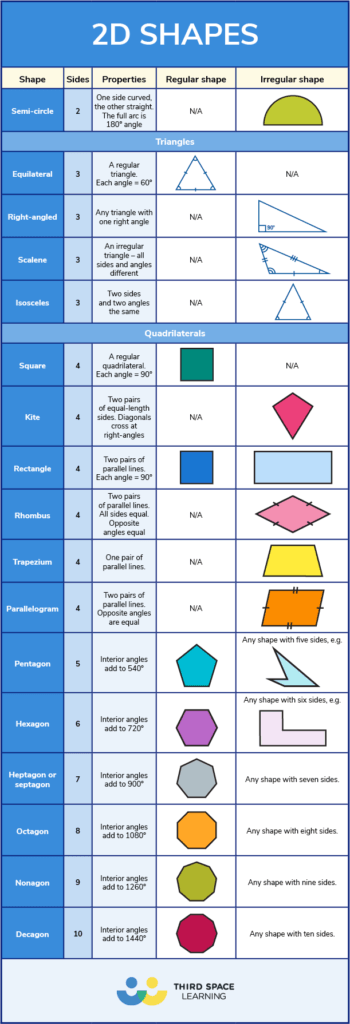
Read more: 2D And 3D Shapes: Properties of Shapes
When do children learn about 2D shapes in primary school?
Geometry is taught in every year group in KS1 and KS2. Here’s what the National Curriculum expects to be taught about 2D shapes:
2D shapes in Year 1
Year 1 pupils should be able to:
- Recognise and name common 2-D and 3-D shapes, including: 2-D shapes [for example, rectangles (including squares), circles and triangles]; 3-D shapes [for example, cuboids (including cubes), pyramids and spheres].
- Non-statutory guidance: Pupils handle common 2-D and 3-D shapes, naming these and related everyday objects fluently. They recognise these shapes in different orientations and sizes, and know that rectangles, triangles, cuboids and pyramids are not always similar to each other.
2D shapes in Year 2
Year 2 pupils should be able to:
- Identify and describe the properties of 2-D shapes, including the number of sides and line symmetry in a vertical line.
- Identify and describe the properties of 3-D shapes, including the number of edges, vertices and faces.
- Identify 2-D shapes on the surface of 3-D shapes, [for example, a circle on a cylinder and a triangle on a pyramid]
- Compare and sort common 2-D and 3-D shapes and everyday objects.
- Non-statutory guidance: Pupils handle and name a wide variety of common 2-D and 3-D shapes, including quadrilaterals and polygons, and cuboids, prisms and cones, and identify the properties of each shape (for example, number of sides, number of faces). Pupils identify, compare and sort shapes on the basis of their properties and use vocabulary precisely, such as sides, edges, vertices and faces.
2D shapes in Year 3
Year 3 pupils should be able to:
- Draw 2-D shapes and make 3-D shapes using modelling materials and recognise 3-D shapes in different orientations and describe them.
- Non-statutory guidance: Pupils’ knowledge of the properties of shapes is extended at this stage to symmetrical and non-symmetrical polygons and polyhedra. Pupils extend their use of the properties of shapes. They should be able to describe the properties of 2-D and 3-D shapes using accurate language, including lengths of lines and acute and obtuse for angles greater or lesser than a right angle.
2D shapes in Year 4
Year 4 pupils should be able to:
- Identify line of symmetry in 2-D shapes presented in different orientations.
- Non-statutory guidance: Pupils continue to classify shapes using geometrical properties, extending to classifying different triangles (for example, isosceles, equilateral, scalene) and quadrilaterals (for example, parallelogram, rhombus, trapezium).
2D shapes in Year 5
Year 5 pupils should be able to:
- Identify 3-D shapes, including cubes and other cuboids, from 2-D representations and distinguish between regular and irregular polygons based on reasoning about equal sides and angles.
2D shapes in Year 6
Year 6 pupils should be able to:
- Draw 2-D shapes using given dimensions and angles and recognise, describe and build simple 3-D shapes, including making nets.
How do 2D shapes relate to other areas of maths?
When working with fractions, children will often have to shade a fraction of a shape. They will have to relate their understanding of perimeter and area to 2D shapes, and they may be required to reflect or translate 2D shapes on a coordinate grid.
2D shapes questions
1. In a quadrilateral, three angles measure 110, 70 and 20 degrees. How many degrees in the missing angle?
(Answer: 160)
2. Which shape has 2 pairs of parallel sides, 2 acute and 2 obtuse angles and no lines of symmetry?
(Answer: parallelogram)
3. Which shape is the odd one out? Why?
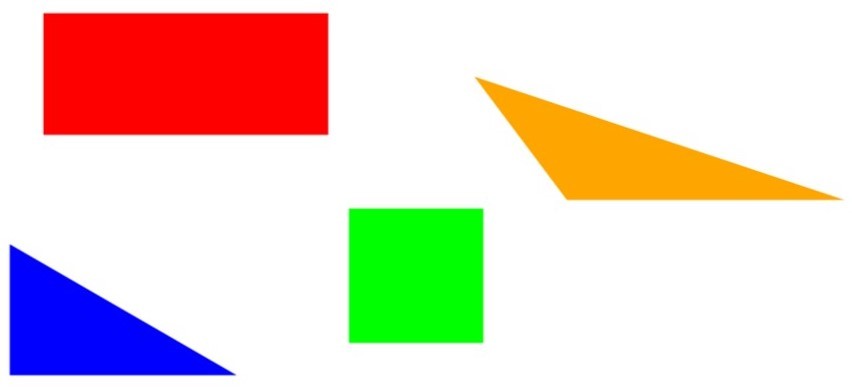
(Answer: The scalene triangle is the odd one out as it is the only shape NOT to have a right angle in it.)
2D shapes worksheets
- Year 2 Independent Recap – 2D Shapes
- Year 6 Maths Code Crackers – 2D and 3D Shape
- Year 3 Ready-to-go Lesson Slides – 2D and 3D Shapes
These are names of the 2D shapes children will need to know at elementary school:
Circle
Triangle
Square
Kite
Rectangle
Rhombus
Trapezoid
Parallelogram
Pentagon
Hexagon
Octagon
Nonagon
Decagon
Wondering about how to explain other key maths vocabulary to your children? Check out our Primary Maths Dictionary For Kids. You could also check out these similar blogs:
DO YOU HAVE STUDENTS WHO NEED MORE SUPPORT IN MATHS?
Skye – our AI maths tutor built by teachers – gives students personalised one-to-one lessons that address learning gaps and build confidence.
Since 2013 we’ve taught over 2 million hours of maths lessons to more than 170,000 students to help them become fluent, able mathematicians.
Explore our AI maths tutoring or find out about a primary school maths tutor for your school.
